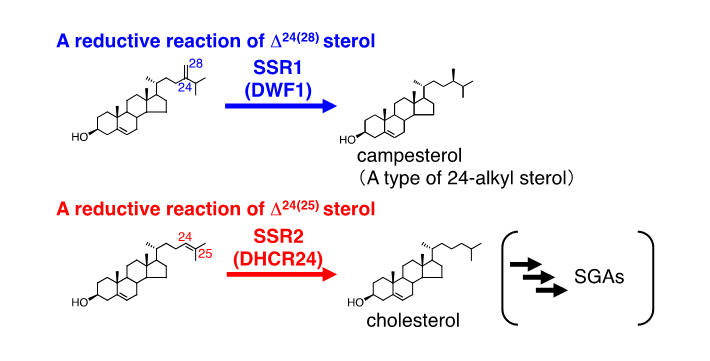Identification of enzyme gene involved in toxic alkaloid biosynthesis in potatoes
Published: October 6, 2014
Identification of enzyme gene involved in toxic alkaloid biosynthesis in potatoes
- Promise for the breeding of potatoes with lower SGA levels -
It is known that steroid glycoalkaloids(1) (SGAs) such as α-solanine and α-chaconine, which cause food poisoning, are contained in potato sprouts and the area near the skin of green tubers. Therefore, controlling and reducing SGA levels are considered to be one of the most important issues in breeding potatoes. SGAs are believed to be biosynthesized from cholesterol as an intermediate. However, as cholesterol levels contained in plants are generally very low, details of their production mechanism have not been clear until now.
Through enzyme function assessment using heterologous gene expression in yeast, the research group, including Assistant professor Kiyoshi Ohyama at Tokyo Institute of Technology, identified the SSR2 gene as an enzyme gene in the biosynthesis of cholesterol necessary for SGA production. The group also discovered that in genetically modified potatoes, in which SSR2 gene expression is decreased or the SSR2 gene is disrupted, SGA levels are relatively low compared to those found in non-genetically modified potatoes. Results of this research suggest that SSR2 holds promise as a target gene in the breeding of potatoes with lower SGA levels.
Results of this research were published on September 12, 2014 in the online edition of U.S. science journal "The Plant Cell" prior to their publication in that journal.
Notes
(1) Steroid Glycoalkaloids:
Steroid glycosides containing nitrogen atom. Solanaceous plants are known to produce and accumulate steroid glycoalkaloids. In potatoes, α-solanine and α-chaconine are known as the main steroid glycoalkaloids and are believed to be causative agents of toxins in potatoes.

Figure. An example of reductive reactions of Δ24(28) and Δ24(25) sterols
SSR1 shows pronounced catalytic activity in the reductive reaction of Δ24(28) sterol and is involved in the biosynthesis of 24-alkyl sterol. SSR2 shows pronounced catalytic activity in the reductive reaction of Δ24(25) sterol, and is involved in the biosynthesis of cholesterol, the intermediate of SGA biosynthesis.
Reference
Authors: |
Satoru Sawai, Kiyoshi Ohyama, Shuhei Yasumoto, Hikaru Seki, Tetsushi Sakuma, Takashi Yamamoto, Yumiko Takebayashi, Mikiko Kojima, Hitoshi Sakakibara, Toshio Aoki, Toshiya Muranaka, Kazuki Saito, and Naoyuki Umemoto |
Journal volume, pages and year: |
The Plant Cell (September 2014) tpc.114.130096 |
Title of original paper: |
Sterol Side Chain Reductase 2 Is a Key Enzyme in the Biosynthesis of Cholesterol, the Common Precursor of Toxic Steroidal Glycoalkaloids in Potato |
Digital Object Identifier (DOI): |
|
. Any information published on this site will be valid in relation to Science Tokyo.



